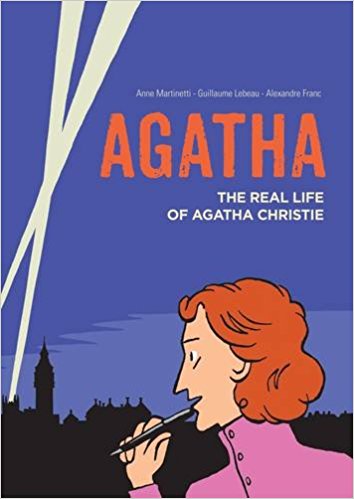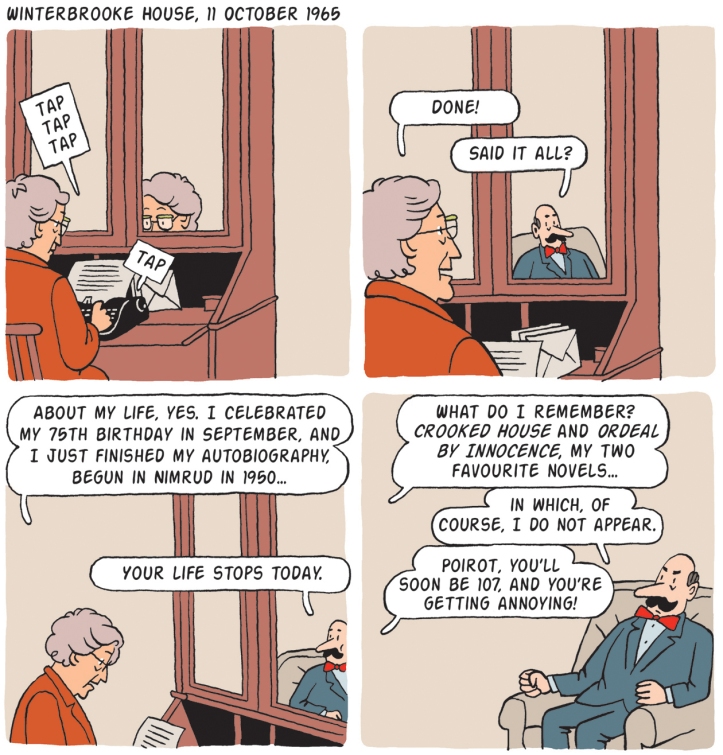Content Warnings: none
Somewhere along the way, my husband acquired the graphic biography Agatha: The Real Life of Agatha Christie by Anne Martinetti. It is co-authored with Guillaume Lebeau, illustrated by Alexandre Franc, translated from French into English by Edward Gauvin, and was published by Self Made Hero in 2016. I’ve stumbled on a couple of graphic biographies recently, and I’m not sure the genre works. Fire!! The Zora Neale Hurston Story was a hot mess. You had to already know Hurston’s life story to understand anything in the graphic memoir. I found the same issue with Agatha.

The book beings December 7, 1926 — and Agatha Christie has vanished. Fortunately, I’d heard this bit of information before. Christie disappears, is found 11 days later, and has no recollection of what happened (or so she says). In Agatha, her husband is accused of killing his wife. Other famous authors, like Arthur Conan Doyle and Dorothy L. Sayers, posit theories as to what happened. Meanwhile, Christie checks into a hotel in Harrogate, “a spa town in North Yorkshire, England.” There, she converses with a man. After a bit, the wacky mustache tipped me off: she’s imagining conversations with Hercule Poirot. In London, someone (Sir Arthur Conan Doyle?) takes one of Christie’s gloves to a medium, who uses the item to transport readers to Christie’s past to see if he can divine where she is.
The plot isn’t meant for someone who wants to learn about Agatha Christie. People come and go without introductions, events happen without reason. Every two pages or so is a new year and location. What I gathered is Christie traveled a lot, had two husbands who cheat, and didn’t spend much time with her daughter, Rosalind. Instead, Christie went to new locations and was inspired by the settings.

Thus, she wrote her novels starring Hercule Poirot, Miss Jane Marple, and Tommy and Tuppence. While all of her detectives make appearances to chat with their creator, Poirot is the most bothersome. Christie is constantly threatening to kill him off. The best part of the book was seeing Christie talk to her detectives like real people. Poirot even sneaks into a ladies-only bath.

The drawing style is simple and clear. The frames reminded me of how Joann Sfar structures his The Rabbi’s Cat books 1 and 2. That little bit of space makes each frame clearly it’s own thing, preventing one frame from blending into another. I appreciated the technique, especially since I just read The Customer is Always Wrong and noted that sometimes the frames aren’t clearly separated. Oddly, both Agatha and The Rabbi’s Cat books are from France. Perhaps this separation of frames and unpolished line around each frame is a French thing? It does make for easier reading.
In the end, I’ve had a little Agatha Christie week here at Grab the Lapels, starting with a review of Murder on the Orient Express. The graphic memoir Agatha wasn’t for me because so much is skipped in the timeline. It’s now, I see, a book written for hardcore fans who may want to see something new about a woman who tried many things: early flight, surfing, archaeology, and disappearing.

Interesting review. Think I’ll give this one a miss.
LikeLike
I can see what you mean about this one not being for those who aren’t ‘hardcore’ about Christie. It does sound like a lot is skipped over. I thought it was interesting that she kept trying to kill Poirot off. In real life, it is said that she got fed up with him completely, but people liked him. So, she felt the need to keep writing about him.
LikeLike
She actually jokes about how she felt about Poirot through her occasional character, Ariadne Oliver, who is a mystery writer with an annoying Swedish detective that she’s fed up with but can’t get rid of. I’m afraid this book doesn’t appeal much to me – can’t quite see the point…
LikeLike
I felt the same way about the Zora Neale Hurston book; there was no point to it if it’s for hardcore fans because it’s so skinny, but it doesn’t appeal to newbies because it’s so skinny.
LikeLiked by 1 person
I’ve only read one Agatha Christie book, so I wouldn’t be too interested in a story like this. I do think her mysterious disappearance is really interesting. I immediately thought of Edgar Allan Poe.
LikeLike
Did Poe disappear too?? 😍
LikeLiked by 1 person
Yes, leading up to his death. He left
Richmond for Philadelphia and was found a week later in Baltimore. The story goes that he was found incoherent in someone else’s clothes and was never awake or coherent enough to explain what happened to him. He died four days later.
LikeLike
Whoa! I did NOT know that!
LikeLiked by 1 person
I understand your feeling here, although I haven’t read this graphic bio. I’ve had that feeling with slim biographies of other writers, when the author was clearly writing for readers with more/less reading experience of the author than that I had myself. For instance, I love Carol Shields’ book about Jane Austen (about whom i know relatively little – the Coles Notes highlights) and I’d heard many readers complain about it; what she says about the writing process itself and identity as a woman with creative ambitions – all that I loved but perhaps doesn’t say a lot about JA. And on the other hand, I expected to love Jane Urquhart’s slim biography of L.M. Montgomery but I have read a lot about LMM and found the Urquhart very light and not a good fit for me. Perhaps the field of biography writing was once much more homogeneous.
LikeLike
I feel like if someone writes to write a biography of a famous person who has been dead for a while, it needs to be new. For instance, in 2018 there is a book about Octavia Butler coming out that went into Butler’s personal papers, which haven’t been published before. I think the graphic biography is just a flop — unless the cartoonist really, really wants to put in some serious work.
LikeLike
This seems to me to be more a fiction – or maybe a fantasy – with Agatha Christie as a character than an attempt at biography. Sort of an in-joke maybe.
LikeLike
Maybe. I definitely didn’t get the in-joke, then!
LikeLike
Hmmm, disappointed to hear this was disappointing. Nevertheless I want to pick it up just for the conversations with Poirot. They seem hilarious.
LikeLike
He is quite a problem throughout. He gets jealous of Miss Marple.
LikeLiked by 1 person
What a petty little man 😂
LikeLike
Since I’ve only read Murder on the Orient Express, I don’t have a feel for him yet, but in my book club we discussed how Orient Express is the 10th book, so if Poirot seems cocky, it’s because he’s 10 murders into his career. Perhaps he’s earned the right to be a know-it-all.
LikeLiked by 1 person
Pfft. At just ten murders? Amateur 😂😂
LikeLiked by 1 person
Oh this looks like something I would really enjoy actually. Also, I had no idea FictionFan’s cats were named after Agatha Christie characters, although I’m really not surprised either 🙂
LikeLike
I think I need to read more graphic biographies before I’m sold on them. If they were thorough, they would have to be quite long. The two I’ve read skip tons of info. Are you a big Christie fan?
LikeLiked by 1 person
I wish I was a bigger fan, I would read more of her books if I didn’t owe so many reviews to so many publishers!
LikeLiked by 1 person
It’s a bit frustrating that you ran into two graphic biographies which left you wanting in a row. I really enjoy graphic memoirs, personally. I’m a bit surprised you ran into two duds, as I find the genre quite effective. Perhaps the difference is biography versus memoir? For example, Persepolis is a really intriguing exploration of the Iranian revolution. I also loved Smile and El Deafo, but both of those were geared towards children.
I don’t know much about Christie’s life. It sounds like this one should be a pass for me until I know more about her.
LikeLike
I agree that there is a difference between graphic memoir and biography. It seems like the memoirs know where to speed up and show down, what to skip and what to keep. The graphic biographies are also about to very famous people; if the authors want to add to the body of work on these famous writers, they need to do something meaningful.
LikeLiked by 1 person
That’s a really good point. I think it’s a lot easier to tell you own story effectively than to tell the story of another person, particularly when you don’t know them personally! I don’t read much when it comes to biography, but memoir is one of my favorite genres. I never stopped to think about why– you are totally on point with this idea.
Do you feel like Martinetti and Lebeau were trying to do something larger and more meaningful by having Christie speak to her characters like this? If so, do you think it was effective? If not, what do you think they could have done to elevate this biography?
LikeLike
I think the only thing that could have saved this biography was to have a clear sense of audience and to market the book clearly to that audience. When I’m teaching, I always try to talk about audience and real-world implications. I was definitely thinking about those lessons as I read.
LikeLiked by 1 person